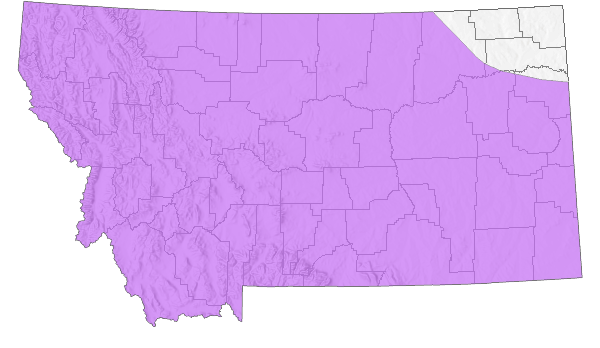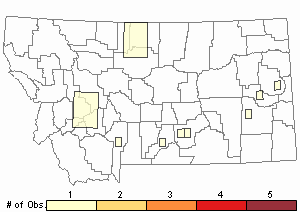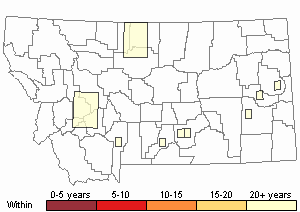View in other NatureServe Network Field Guides
NatureServe
Montana
Utah
Wyoming
Idaho
Wisconsin
British Columbia
South Carolina
Yukon
California
New York
Broad-banded Grasshopper - Trimerotropis latifasciata
General Description
The following is taken from Hebard (1928), Brooks (1958), Helfer (1971), Capinera and Sechrist (1982), Otte (1984), Vickery and Kevan (1985) Richman et al. (1993), Capinera et al. (2004), Brust et al. (2008), and Scott (2010). This large grasshopper is grayish to reddish-brown with two distinct dark bands on the tegmina (forewings) and pale bands between. The pale bands are constricted in the dorsal half of the wing, widening ventrally. The pronotum (thorax) is delicately textured, cut with shallow sulci (grooves). The median carina (ridge) is usually low and often faint on the posterior two-thirds of the pronotum. The hindwing disk is pale yellow, sometimes whitish, with a broad black band, sometimes wider than the disk, with a short, thick spur extending less than halfway to the base. The outer face of the hind femur is pale with a poorly developed black band which may be absent. The inner face of the hind femur is pale or orangish, with the apical area black and a black band and knee, very similar to
Barren Land Grasshopper (
T. pistinaria). The hind tibia is red or bright orange with a pale-yellow marking on the outer surface at the base. Dark forms often occur where the anterior dark band of the tegmina is wide merging to the wing base and the outer face of the hind femur is dark with a terminal pale band (see images).
Communicative behavior/Crepitation* Considered to be a strong erratic flier and difficult to capture, producing a soft crepitation. No other behaviors or signals have been reported in the literature (Vickery and Kevan 1985).
*Crepitation is the sound produced by grasshoppers making a clicking or snapping noise with their wings when in flight, during courtship, territorial encounters or being disturbed.
Phenology
This species overwinters in the egg stage. Nymphs appear from May to early June. Adults occur from early July to September (Capinera and Sechrist 1982, Otte 1984, Vickery and Kevan 1985, Capinera et al. 2004, Brust et al. 2008, and Scott 2010).
Diagnostic Characteristics
The following comes from Hebard (1928), Brooks (1958), Helfer (1971), Capinera and Sechrist (1982), Otte (1984), Vickery and Kevan (1985), Richman et al. (1993), Capinera et al. (2004), Brust et al. (2008), and Scott (2010). The body length to the tip of forewings is 30-41 mm for males, and 37-49 mm for females.
In Montana, this species can be easily confused with
Barren Land Grasshopper (
T. pistinaria) and sometimes with
Say’s Grasshopper (
Spharagemon equale) (Otte 1984, and Scott 2010).
Species Range
Montana Range
Range Descriptions

 Native
Native
Range Comments
This species ranges from the north in southern Alberta to Manitoba, southward to central Mexico. West to east from Washington, Oregon, and California, to North Dakota, southward across the Great Plains to Texas. In Montana, it has been reported for 18 counties (Otte 1984, Vickery and Kevan 1985, Capinera et al. 2004, and Scott 2010).
Observations in Montana Natural Heritage Program Database
Number of Observations: 10
(Click on the following maps and charts to see full sized version)
Map Help and Descriptions
Relative Density

Recency


 (Observations spanning multiple months or years are excluded from time charts)
(Observations spanning multiple months or years are excluded from time charts)
Habitat
The Broad-banded Grasshopper inhabits open dry grasslands, often with bare, sandy-alkaline flats where the conspicuous vegetation consists of sagebrush,
Artemesia sp. and
Greasewood (
Sarcobatus vermiculatus). Vegetative habitat cover can vary from sparse to dense combinations of shrubs, grasses, and forbs (Otte 1984, and Vickery and Kevan 1985).
Food Habits
This species is a mixed feeder, preferring
Western wheatgrass (
Agropyron smithii) (Brooks 1958, Otte 1984, and Vickery and Kevan 1985).
Reproductive Characteristics
Unknown.
Stewardship Responsibility
References
- Literature Cited AboveLegend:
 View Online Publication
View Online Publication Brooks, A.R. 1958. Acridoidea of Southern Alberta, Saskatchewan, and Manitoba (Orthoptera). The Canadian Entomologist (Supplement 9) 90:5-92.
Brooks, A.R. 1958. Acridoidea of Southern Alberta, Saskatchewan, and Manitoba (Orthoptera). The Canadian Entomologist (Supplement 9) 90:5-92. Brust, M.L, W.W. Hoback, and R.J. Wright. 2008. The Grasshoppers of Nebraska. Lincoln, NB: University of Nebraska Extension Service, APHIS.
Brust, M.L, W.W. Hoback, and R.J. Wright. 2008. The Grasshoppers of Nebraska. Lincoln, NB: University of Nebraska Extension Service, APHIS. Capinera, J.L. and T.S. Sechrist. 1982. Grasshoppers of Colorado: Identification, Biology, and Management. Fort Collins, CO: Colorado State University Experiment Station, Bulletin 584S. 161 p.
Capinera, J.L. and T.S. Sechrist. 1982. Grasshoppers of Colorado: Identification, Biology, and Management. Fort Collins, CO: Colorado State University Experiment Station, Bulletin 584S. 161 p. Capinera, J.L., R.D. Scott, and T.J. Walker. 2004. Field Guide to Grasshoppers, Katydids, and Crickets of the United States. Ithaca, NY. Cornell University Press.
Capinera, J.L., R.D. Scott, and T.J. Walker. 2004. Field Guide to Grasshoppers, Katydids, and Crickets of the United States. Ithaca, NY. Cornell University Press. Hebard, M. 1928. The Orthoptera of Montana. Proceedings of the Academy of Natural Sciences of Philadelphia, Vol. 80:211-306.
Hebard, M. 1928. The Orthoptera of Montana. Proceedings of the Academy of Natural Sciences of Philadelphia, Vol. 80:211-306. Helfer, J.R. 1971. How to Know the Grasshoppers, Crickets, Cockroaches, and Their Allies. Revised edition (out of print), Mineola, NY: Dover Publications.
Helfer, J.R. 1971. How to Know the Grasshoppers, Crickets, Cockroaches, and Their Allies. Revised edition (out of print), Mineola, NY: Dover Publications. Otte, Daniel. 1984. The North American Grasshoppers Volume II. Acrididae (Oedipodinae). Harvard University Press. 366 pp.
Otte, Daniel. 1984. The North American Grasshoppers Volume II. Acrididae (Oedipodinae). Harvard University Press. 366 pp. Richman, D.B., D.C. Lightfoot, C.A. Sutherland, and D.J. Ferguson. 1993. A manual of the grasshoppers of New Mexico. Las Cruces, NM: Cooperative Extension Service, Handbook No. 7.
Richman, D.B., D.C. Lightfoot, C.A. Sutherland, and D.J. Ferguson. 1993. A manual of the grasshoppers of New Mexico. Las Cruces, NM: Cooperative Extension Service, Handbook No. 7. Scott, R.D. 2010. Montana Grasshoppers, Katydids, and Crickets A Pictorial Field Guide to the Orthoptera. MagpieMTGraphics, Billings, MT.
Scott, R.D. 2010. Montana Grasshoppers, Katydids, and Crickets A Pictorial Field Guide to the Orthoptera. MagpieMTGraphics, Billings, MT. Vickery, V. R. and D. K. M. Kevan. 1985. The grasshopper, crickets, and related insects of Canada and adjacent regions. Biosystematics Research Institute, Ottawa, Ontario. Publication Number 1777. 918 pp.
Vickery, V. R. and D. K. M. Kevan. 1985. The grasshopper, crickets, and related insects of Canada and adjacent regions. Biosystematics Research Institute, Ottawa, Ontario. Publication Number 1777. 918 pp.
- Additional ReferencesLegend:
 View Online Publication
View Online Publication
Do you know of a citation we're missing? Skinner, K.F. 1995. Plant and grasshopper community composition: indicators & interactions across three spatial scales. M.Sc. Thesis. Bozeman, MT: Montana State University. 144 p.
Skinner, K.F. 1995. Plant and grasshopper community composition: indicators & interactions across three spatial scales. M.Sc. Thesis. Bozeman, MT: Montana State University. 144 p.
- Web Search Engines for Articles on "Broad-banded Grasshopper"
- Additional Sources of Information Related to "Insects"





